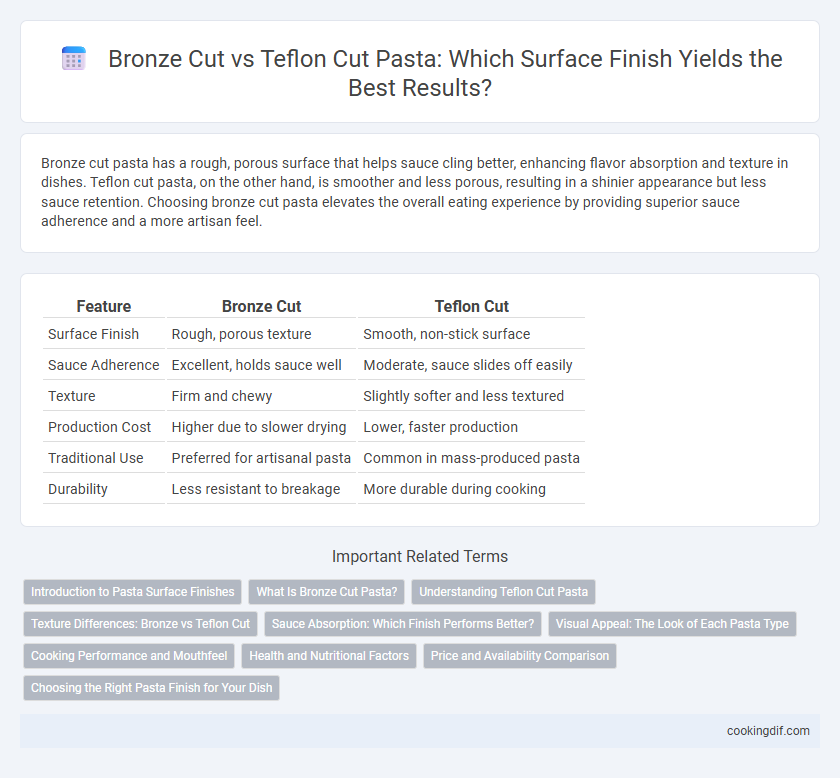Bronze cut pasta has a rough, porous surface that helps sauce cling better, enhancing flavor absorption and texture in dishes. Teflon cut pasta, on the other hand, is smoother and less porous, resulting in a shinier appearance but less sauce retention. Choosing bronze cut pasta elevates the overall eating experience by providing superior sauce adherence and a more artisan feel.
Table of Comparison
| Feature | Bronze Cut | Teflon Cut |
|---|---|---|
| Surface Finish | Rough, porous texture | Smooth, non-stick surface |
| Sauce Adherence | Excellent, holds sauce well | Moderate, sauce slides off easily |
| Texture | Firm and chewy | Slightly softer and less textured |
| Production Cost | Higher due to slower drying | Lower, faster production |
| Traditional Use | Preferred for artisanal pasta | Common in mass-produced pasta |
| Durability | Less resistant to breakage | More durable during cooking |
Introduction to Pasta Surface Finishes
Bronze cut pasta features a rougher surface texture due to the traditional bronze dies, which enhances sauce adherence by creating microscopic grooves. Teflon cut pasta, produced with smooth non-stick dies, results in a sleek surface that repels sauces, leading to a different mouthfeel and flavor experience. The choice between bronze and Teflon cut significantly impacts the pasta's ability to hold various sauces and the overall culinary quality.
What Is Bronze Cut Pasta?
Bronze cut pasta is made using traditional bronze dies that create a rough, porous surface ideal for holding onto sauces and enhancing flavor absorption. Unlike Teflon cut pasta, which has a smooth, shiny finish due to non-stick coatings, bronze cut pasta offers a more textured consistency that improves sauce adherence and overall mouthfeel. The porous surface also allows for better drying, resulting in a thicker and more robust pasta shape favored in authentic Italian cooking.
Understanding Teflon Cut Pasta
Teflon cut pasta features a smooth, non-porous surface due to the use of Teflon-coated dies, resulting in less sauce adhesion compared to bronze cut pasta. This smooth finish leads to a delicate texture and glossy appearance, ideal for lighter, cream-based sauces that don't require strong grip. Understanding the differences in surface finish helps select the right pasta type to enhance the overall dish experience.
Texture Differences: Bronze vs Teflon Cut
Bronze-cut pasta features a rough, porous texture that helps sauces cling better, enhancing flavor absorption and mouthfeel. Teflon-cut pasta has a smoother surface, resulting in a silkier texture but less sauce adherence. The choice impacts cooking performance, with bronze-cut preferred for robust dishes requiring strong sauce retention.
Sauce Absorption: Which Finish Performs Better?
Bronze cut pasta features a rough, porous surface that enhances sauce absorption by allowing sauces to cling better, resulting in a more flavorful dish. Teflon cut pasta has a smoother finish, which causes sauces to slide off more easily, reducing the intensity of flavor absorption. For chefs seeking optimal sauce retention and a richer taste experience, bronze cut pasta consistently outperforms Teflon cut in sauce absorption.
Visual Appeal: The Look of Each Pasta Type
Bronze-cut pasta has a rough, porous surface that holds sauce better and offers a rustic, artisanal appearance highly prized in traditional Italian cuisine. Teflon-cut pasta features a smooth, glossy finish that gives it a more refined and uniform look, appealing to modern culinary aesthetics. The visual texture of bronze-cut pasta enhances the perception of authenticity and handmade quality, while Teflon-cut pasta's sleek surface conveys elegance and consistency.
Cooking Performance and Mouthfeel
Bronze cut pasta features a rough, porous surface that absorbs sauce effectively, enhancing flavor retention and creating a firm, al dente texture preferred in traditional Italian cooking. Teflon cut pasta has a smoother, less porous finish, resulting in a silkier mouthfeel but reduced sauce adherence, which can lead to a blander taste experience. The choice between bronze and Teflon cut directly impacts cooking performance and mouthfeel, with bronze-cut pasta offering superior sauce clinging and a more textured bite.
Health and Nutritional Factors
Bronze-cut pasta has a rougher surface texture that enhances sauce adhesion, promoting better flavor absorption and nutrient intake, while Teflon-cut pasta produces a smoother finish that may result in less sauce retention and diminished taste intensity. The bronze-cut process involves slower extrusion at lower temperatures, preserving more nutrients like B vitamins compared to the faster, heat-intensive Teflon-cut method that can degrade sensitive nutrients. Choosing bronze-cut pasta aligns with health-conscious preferences due to its improved digestibility and potential for higher nutrient retention in cooked pasta.
Price and Availability Comparison
Bronze-cut pasta features a rougher texture that allows sauces to cling better, typically priced higher due to its traditional manufacturing process and limited production. Teflon-cut pasta has a smoother surface, produced more efficiently with non-stick dies, resulting in lower prices and wider availability in mass markets. Consumers seeking artisanal quality often opt for bronze-cut pasta despite its premium cost and less frequent stock.
Choosing the Right Pasta Finish for Your Dish
Bronze-cut pasta features a rough, porous surface that holds sauces exceptionally well, enhancing flavor absorption and creating a more authentic texture. Teflon-cut pasta, with its smooth and shiny finish, offers a sleek appearance and firmer bite, ideal for lighter sauces or delicate preparations. Selecting the right pasta finish depends on the sauce's consistency; bronze-cut complements hearty, chunky sauces, while teflon-cut pairs best with thin, subtle dressings.
Bronze cut vs Teflon cut for surface finish Infographic

 cookingdif.com
cookingdif.com